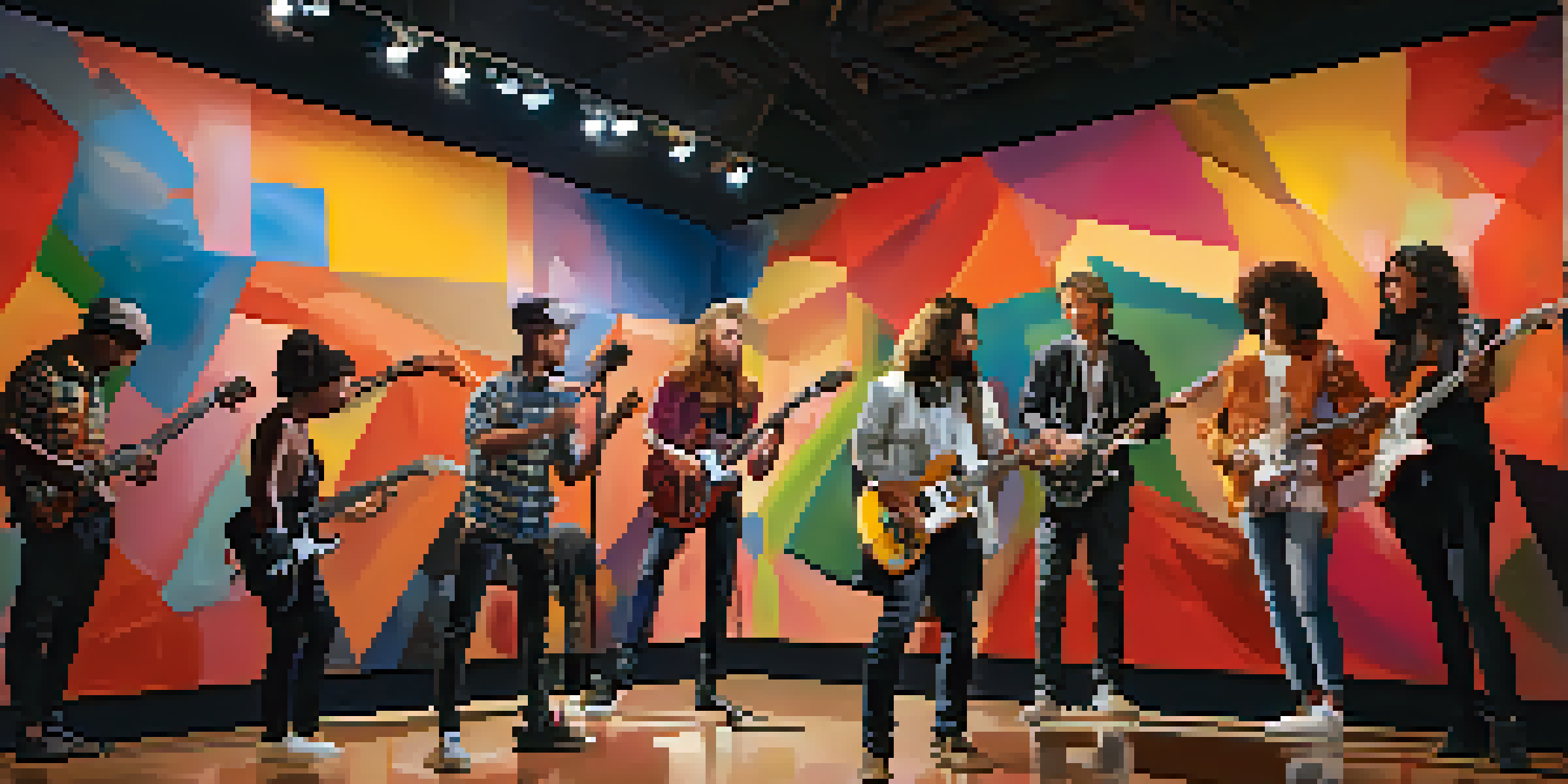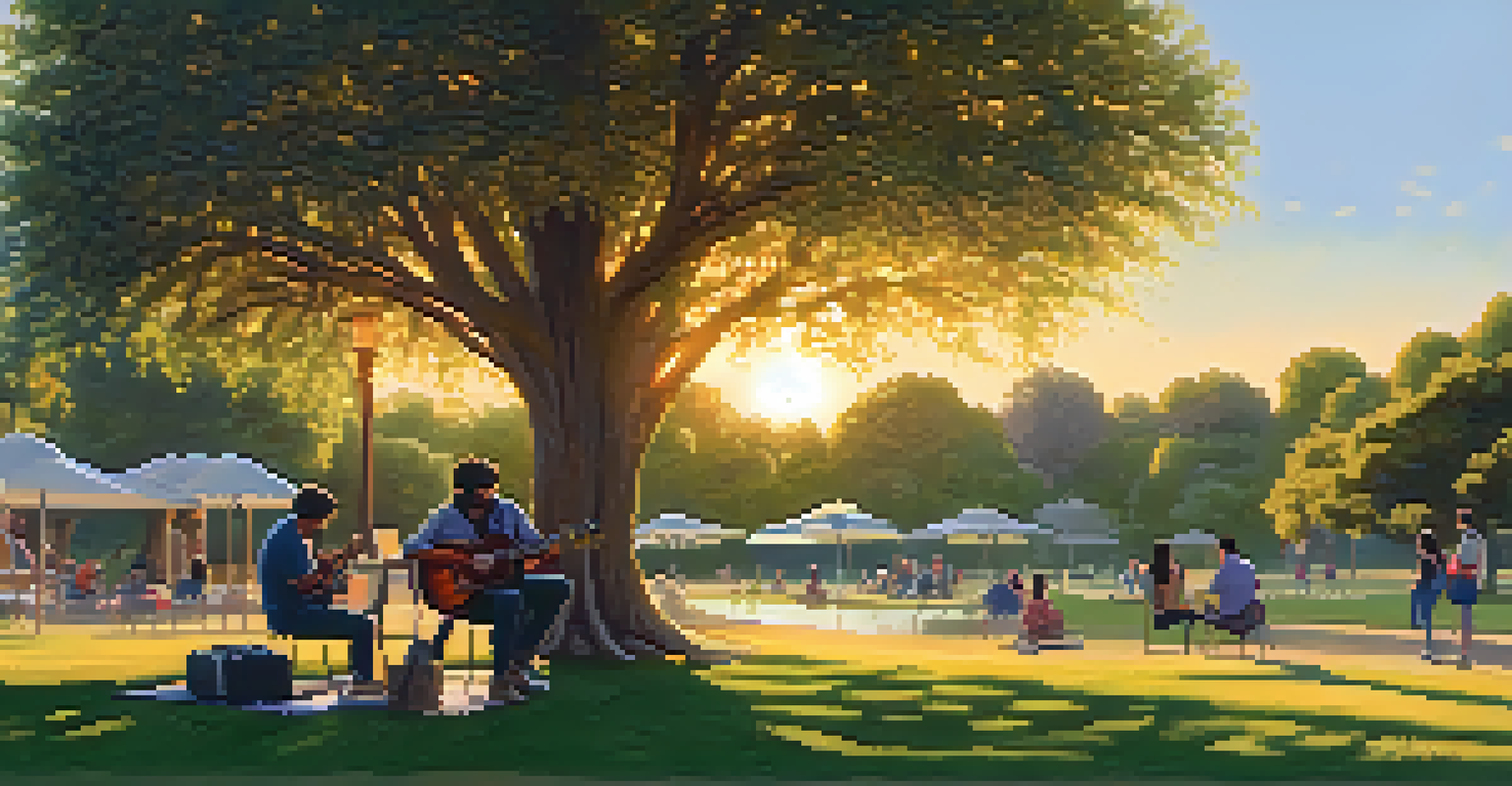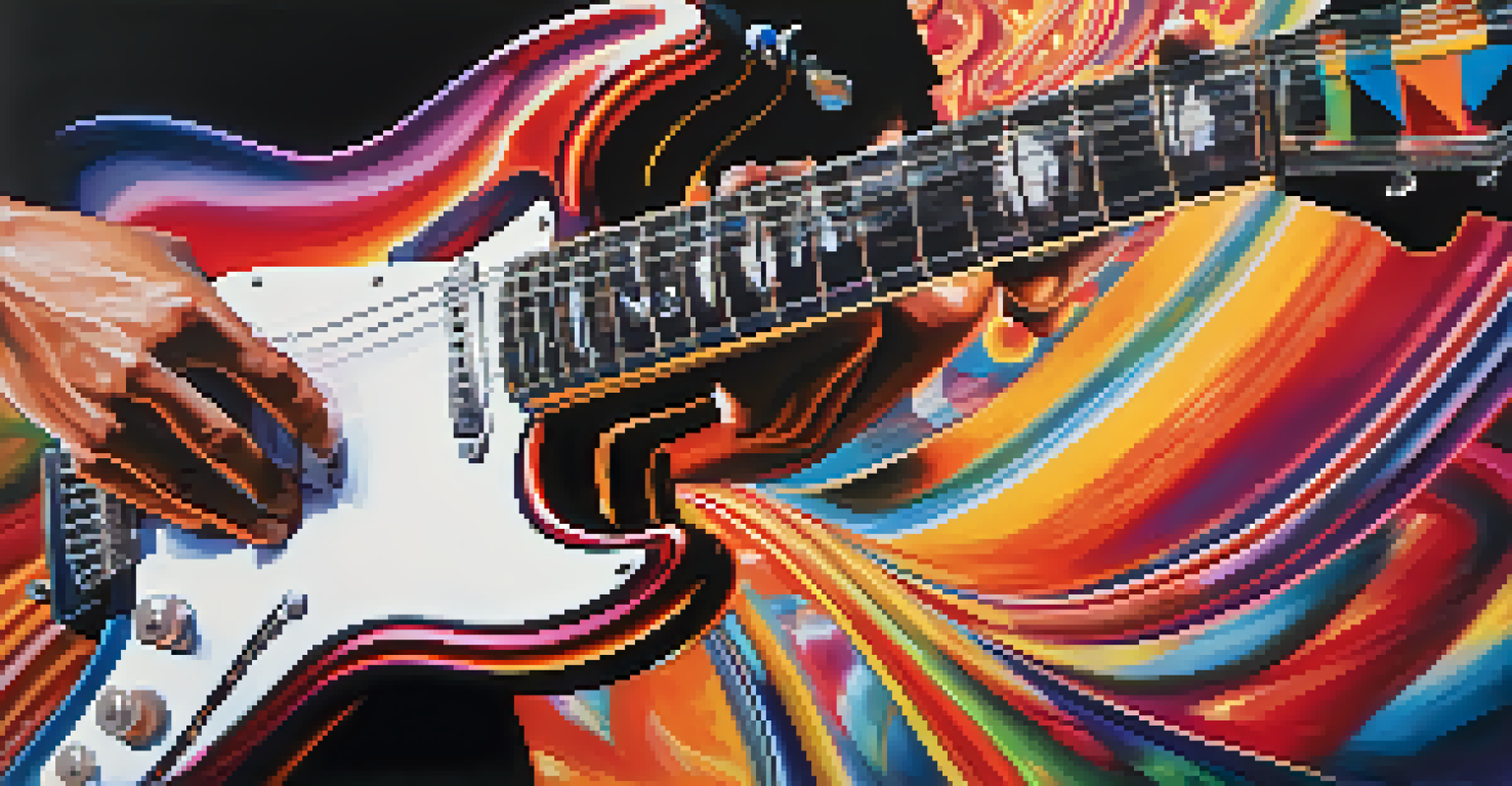Guitar Improvisation in Live Art Installations

Understanding Guitar Improvisation and Its Significance
Guitar improvisation is the art of spontaneously creating music on the guitar. Unlike pre-composed pieces, improvisation allows musicians to express emotions and ideas in real-time, offering a unique experience with every performance. This spontaneity is not only liberating for the musician but also creates a sense of intimacy with the audience, drawing them into a shared moment of creativity.
Improvisation is not a skill; it’s a lifestyle. It’s a way of being and a way of connecting with the world around you.
In the context of live art installations, guitar improvisation takes on an even deeper significance. It serves as a bridge between visual art and music, enhancing the overall sensory experience of the audience. By weaving spontaneous melodies into the fabric of an art piece, the musician can evoke emotions that resonate with the visual elements before them, creating a harmonious dialogue between the two art forms.
Moreover, this form of improvisation encourages collaboration among artists. Visual artists can respond to the guitar’s sounds with their visual expressions, resulting in a dynamic interplay that keeps evolving throughout the performance. This synergy can lead to unexpected and profound artistic moments that highlight the creativity inherent in both music and visual art.
The Role of Environment in Live Guitar Improvisation
The environment plays a crucial role in shaping the experience of guitar improvisation during live art installations. Whether in a gallery, museum, or outdoor setting, the space influences how the music is perceived and felt. For instance, an open-air installation might encourage more expansive, free-flowing improvisation, while a confined space may lead to more intimate, intricate musical expressions.

Additionally, the acoustics of the environment can enhance or challenge the performance. Musicians often adjust their playing style based on how sound resonates within a given space. In a cavernous room, the echo can create a lush, layered effect, while in a small gallery, the focus may shift to clarity and precision, allowing every note to shine.
Guitar Improvisation Creates Connection
This spontaneous musical expression fosters intimacy between musicians and audiences, enhancing the overall experience.
Furthermore, the presence of the audience contributes to the improvisational process. Their reactions, movements, and energy can influence the musician’s choices, creating a real-time feedback loop. This connection adds another layer to the performance, making it a truly communal experience where everyone involved becomes part of the artwork.
Techniques Used in Guitar Improvisation
Guitar improvisation encompasses a variety of techniques that musicians can employ to create compelling performances. Techniques such as bending notes, using slides, and incorporating harmonics allow for a wide range of emotional expression. Each technique can evoke different feelings, from joy to melancholy, providing depth to the improvisation.
The audience is the most important part of the performance. Without them, it’s just a rehearsal.
Additionally, musicians often rely on scales and modes to guide their improvisation. Understanding these scales helps guitarists navigate through different musical ideas while maintaining a cohesive sound. For example, using a pentatonic scale can create a bluesy feel, while a mixolydian mode may introduce a more upbeat, folksy vibe.
Moreover, rhythm plays a vital role in shaping the improvisational journey. By experimenting with syncopation and varying tempos, guitarists can add excitement and tension to their performance. This rhythmic versatility allows for spontaneous interactions with other artists and enhances the overall impact of the live installation.
Collaboration Between Guitarists and Visual Artists
Collaboration is at the heart of live art installations, where guitarists and visual artists come together to create a multisensory experience. When musicians improvise alongside visual art, they can react to the colors, shapes, and movements unfolding in front of them. This responsiveness can lead to an electrifying atmosphere where both art forms enhance each other.
For instance, a guitarist might find inspiration in a visual artist's brushstrokes, allowing their music to flow in sync with the movement of the paint. This interplay can result in a captivating performance that transcends traditional boundaries, inviting the audience to engage with both the sound and the visuals in a unique way. The fusion of these art forms can create a richer narrative that captivates viewers.
Environment Influences Performance
The setting of live art installations shapes how guitar improvisation is perceived, affecting both acoustics and audience interaction.
This collaborative spirit also encourages experimentation. Guitarists and visual artists can push each other’s creative boundaries, leading to innovative performances that might not occur in isolation. The unpredictability of live improvisation adds an element of surprise, ensuring that each collaboration is distinct and memorable.
The Audience's Role in Live Guitar Improvisation
In live art installations, the audience plays an integral role in the improvisational process. Their reactions, whether through applause, movement, or silence, can influence the direction of the performance. A responsive audience can energize the guitarist, prompting them to explore new musical ideas or intensify their playing.
Moreover, the audience's presence can create a sense of community. As spectators engage with the art and music, they share a collective experience that fosters connection and dialogue. This shared moment can elevate the performance, making it more than just a display of talent; it becomes an interactive event where everyone contributes to the atmosphere.
Additionally, the audience's interpretation of the performance can vary widely. Each listener brings their own perspective and emotions to the experience, which can alter how they perceive the music and visuals. This diversity of interpretation adds layers of meaning, enriching the overall impact of the improvisation and the installation.
Challenges in Guitar Improvisation During Live Installations
While guitar improvisation can be exhilarating, it also presents unique challenges in live art installations. One significant challenge is the need for adaptability. Musicians must be prepared to shift their approach based on the evolving dynamics of the performance and the reactions of both visual artists and the audience. This requires a high level of creativity and confidence.
Another challenge is overcoming performance anxiety. The spontaneous nature of improvisation can be daunting, especially in front of an audience. Musicians may struggle with self-doubt or fear of making mistakes, which can hinder their ability to fully express themselves. However, embracing the possibility of imperfection can lead to authentic moments that resonate deeply with listeners.
Collaboration Enriches Artistic Expression
The synergy between guitarists and visual artists leads to innovative performances that captivate and engage audiences.
Lastly, technical considerations, such as sound quality and equipment, can impact the performance. Musicians need to ensure their guitar sounds clear and balanced within the installation's space. Navigating these technical aspects while maintaining the creative flow can be a delicate balancing act, but overcoming these hurdles often results in a more powerful performance.
The Future of Guitar Improvisation in Art Installations
As the art world continues to evolve, so too does the role of guitar improvisation in live installations. With advancements in technology, musicians are now able to incorporate electronic effects and looping techniques, expanding their sonic palette. This fusion of traditional guitar playing with modern technology can lead to innovative performances that captivate audiences in new ways.
Furthermore, the growing interest in interdisciplinary art encourages collaboration among diverse artists. Guitarists are increasingly finding opportunities to work with dancers, poets, and multimedia creators, resulting in immersive experiences that blur the lines between different art forms. This trend reflects a broader movement toward inclusivity and experimentation in the arts.

Looking ahead, the future of guitar improvisation in live art installations promises to be dynamic and engaging. As artists continue to push boundaries and explore new ideas, audiences can expect to witness extraordinary performances that challenge their perceptions of both music and visual art, ultimately enriching the cultural landscape.